

David Driskell. American painter Woman with Flowers by David Driskell, 1972 The University of Maryland, College Park Art Gallery celebrated its 50th anniversary on Feb. 24, 2016, with a memorable art exhibition.
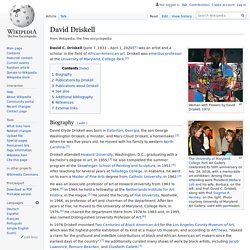
Among those attending were President Wallace Loh and his wife, Barbara, on the left; and Prof. David C. Hairy Who. Jim Nutt briefly attends college at the University of Kansas, then the University of Pennsylvania, then Washington University in St.
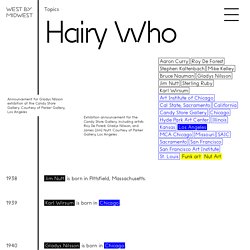
Louis. He eventually settles on the School of the Art Institute of Chicago (SAIC), where he meets his future wife, Gladys Nilsson. François Boucher. 18th-century French painter François Boucher ( BOO-shay, boo-SHAY, French: [fʁɑ̃swa buʃe]; 29 September 1703 – 30 May 1770) was a French painter, draughtsman and etcher, who worked in the Rococo style.

Boucher is known for his idyllic and voluptuous paintings on classical themes, decorative allegories, and pastoral scenes. He was perhaps the most celebrated painter and decorative artist of the 18th century. Life[edit] A native of Paris, Boucher was the son of a lesser known painter Nicolas Boucher, who gave him his first artistic training. In 1720, he won the elite Grand Prix de Rome for painting, but did not take up the consequential opportunity to study in Italy until five years later, due to financial problems at the Académie royale de peinture et de sculpture.[1] On his return from studying in Italy he was admitted to the refounded Académie de peinture et de sculpture on 24 November 1731.[2] His morceau de réception (reception piece) was his Rinaldo and Armida of 1734.[2] Gallery[edit]
Artemisia Gentileschi. Italian Baroque painter Artemisia Lomi or Artemisia Gentileschi (US: /ˌdʒɛntɪˈlɛski, -tiːˈ-/,[1][2] Italian: [arteˈmiːzja dʒentiˈleski]; July 8, 1593 – c. 1656) was an Italian Baroque painter, today considered one of the most accomplished painters in the generation following that of Caravaggio.
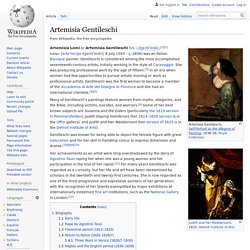
In an era when female painters were not easily accepted by the artistic community or patrons, she was the first woman to become a member of the Accademia di Arte del Disegno in Florence and had international clientele.[3][4] Nam June Paik. Nam June Paik (Korean: 백남준, July 20, 1932 – January 29, 2006) was a Korean American artist.
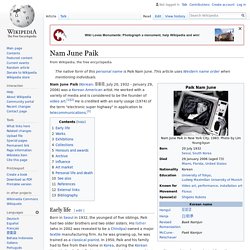
He worked with a variety of media and is considered to be the founder of video art.[1][2] He is credited with an early usage (1974) of the term "electronic super highway" in application to telecommunications.[3] Early life[edit] Paik then moved to West Germany to study music history with composer Thrasybulos Georgiades at Munich University.[4] While studying in Germany, Paik met the composers Karlheinz Stockhausen and John Cage and the conceptual artists George Maciunas, Joseph Beuys and Wolf Vostell and was from 1962 on, a member of Fluxus.[5][6] Works[edit] Pre-Bell-Man, statue in front of the 'Museum für Kommunikation', Frankfurt am Main, Germany Nam June Paik then began participating in the Neo-Dada art movement, known as Fluxus, which was inspired by the composer John Cage and his use of everyday sounds and noises in his music. Cage suggested Paik look into Oriental music and Oriental religion. David Olere. David Olère was born in Warsaw on January 19, 1902, where he studied at the Academy of Fine Arts.
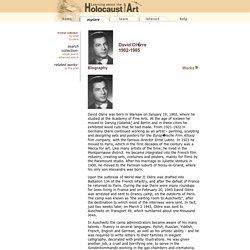
At the age of sixteen he moved to Danzig (Gdansk) and Berlin and in these cities he exhibited wood cuts that he had made. From 1921-1922 in Germany Olère continued working as an artist - painting, sculpting and designing sets and posters for the Europische Film Allianz film company, with the famous director Ernst Lubitz. In 1923 he moved to Paris, which in the first decades of the century was a Mecca for art. Like many artists of the time, he lived in the Montparnasse district. He became integrated into the French film industry, creating sets, costumes and posters, mainly for films by the Paramount studio.
Upon the outbreak of World War II Olère was drafted into Battalion 134 of the French infantry, and after the defeat of France he returned to Paris. When the camp was evacuated on January 19, 1945, he took part in the Death March. Mark Rothko. Mark Rothko (Latvian: Markus Rotkovičs, Russian: Марк Ро́тко; born Ма́ркус Я́ковлевич Ротко́вич; Marcus Yakovlevich Rothkowitz; September 25, 1903 – February 25, 1970) was an American painter of Russian Jewish descent.

He is generally identified as an Abstract Expressionist, although he himself rejected this label and even resisted classification as an "abstract painter. " Élisabeth Vigée Le Brun. 18th and 19th-century French painter Élisabeth Louise Vigée Le Brun (also spelt Vigée-Lebrun; French pronunciation: [elizabɛt lwiz viʒe ləbʁœ̃]; 16 April 1755 – 30 March 1842),[1] also known as Madame Le Brun, was a prominent French portrait painter of the late 18th century.
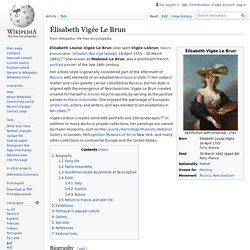
Her artistic style is generally considered part of the aftermath of Rococo with elements of an adopted Neoclassical style.[2] Her subject matter and color palette can be classified as Rococo, but her style is aligned with the emergence of Neoclassicism. Vigée Le Brun created a name for herself in Ancien Régime society by serving as the portrait painter to Marie Antoinette.